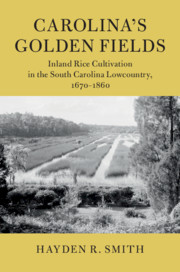Book contents
- Carolina’s Golden Fields
- Cambridge Studies on the American South
- Carolina’s Golden Fields
- Copyright page
- Dedication
- Contents
- Figures
- Table
- Acknowledgments
- 1 Introduction
- 2 Simple Reserves
- 3 The “Golden Mines of Carolina”
- 4 “To Depend Altogether on Reservoirs”
- 5 “The Rice Fields which Are Sown Have Been Partially Flowed”
- 6 Inland Rice Cultivation and the Promise of Agricultural Reform
- 7 Epilogue
- Appendix
- Bibliography
- Index
2 - Simple Reserves
Early Development of Inland Rice, 1670–1729
Published online by Cambridge University Press: 28 October 2019
- Carolina’s Golden Fields
- Cambridge Studies on the American South
- Carolina’s Golden Fields
- Copyright page
- Dedication
- Contents
- Figures
- Table
- Acknowledgments
- 1 Introduction
- 2 Simple Reserves
- 3 The “Golden Mines of Carolina”
- 4 “To Depend Altogether on Reservoirs”
- 5 “The Rice Fields which Are Sown Have Been Partially Flowed”
- 6 Inland Rice Cultivation and the Promise of Agricultural Reform
- 7 Epilogue
- Appendix
- Bibliography
- Index
Summary
Chapter 2 discusses early rice-cultivation strategies in South Carolina from the grain’s approximate introduction in 1685 to the end of the proprietary period in 1729. During this time, colonists transformed the grain from one of several experimental commercial ventures into the central cash crop of early-colonial South Carolina. This chapter also discusses the dynamic relationship of rice farming with topography and culture. European colonists began experimenting with rice cultivation alongside wheat and barley, as well as cotton and tobacco. At the same time, Africans' knowledgeable of growing rice made it thrive in wetland areas for the necessary subsistence gardens. By the turn of the eighteenth century, these two cultural interpretations of rice farming merged to produce grain on small-stream floodplains.At the heart of this chapter is an analysis of how both free and enslaved people used various topographies to cultivate a particular grain and the lasting results that evolved from the early plantation landscape.
Keywords
- Type
- Chapter
- Information
- Carolina's Golden FieldsInland Rice Cultivation in the South Carolina Lowcountry, 1670–1860, pp. 12 - 51Publisher: Cambridge University PressPrint publication year: 2019



